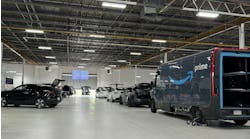So you’ve gone through the interview process, found the perfect candidate, and offered a job. The next step is to hand the new employee a toolbox, show them their stall and put them to work, right? Not if you want the new hire to work out.
“The classic thing I hear from shop owners is that they hire somebody, put them in a bay, and hope for the best—only to discover later on that person isn’t performing,” says Richard Pannazzo, director of franchise sales and operations for Anaheim Hills, Calif.–based Fix Auto USA. “The first thing I ask is whether they took time to set proper expectations, and teach about the shop’s culture, vision and processes before putting them to work.”
The answer is often “no,” a big mistake after taking on a new employee. Young technicians are still learning the ropes in the industry, and experienced technicians often bring already-ingrained (and sometimes bad) work habits from other shops that need to be broken. You can’t expect new employees to have success in your operation without a training, assessment and coaching process to indoctrinate them into your organization.
Pannazzo recommends that all shops implement a step-by-step process for doing just that. Taking time to educate every new employee on your company-specific culture, policies, work processes and expectations ensures they’re systematically equipped with the knowledge and training to fit in and adhere to standards and expectations inside your shop from the day they start.
Pannazzo outlines an employee training process used by every Fix Auto franchise—a standard procedure that all independent shops can easily replicate when new employees show up for work.
Step #1: Policy Training
In addition to your employee handbook, train new employees on shop policies and expectations. Outline things such as their role in the shop, work habits and OSHA safety requirements.
Richard Fish, owner of four collision centers in California—including three Fix Auto shops—has an environmental firm come to the shop to counsel new employees on identification of safety risks and other OSHA-related issues.
“While we could do that internally, I find that training to be notably more effective by having an external firm with professional OSHA knowledge deliver it,” Fish says.
Step #2: Facility Tour and Orientation
Walk the new employee through the shop, and introduce them in person to the rest of your staff, Pannazzo says. Give them a few minutes to speak one-on-one with each individual in your organization. In addition, provide them with as much background information on their co-workers as possible, including phone numbers, email addresses and areas of expertise.
Pannazzo says that helps develop repair quality and accuracy. New hires, especially entry-level technicians, know who can provide them with expert information and assistance if they run into problems in various situations.
Fish takes every new staff member on tours of his facility. He says it’s a comprehensive, two-hour tour that exposes employees to the shop’s workflow, processes and standard operating procedures (SOPs) for each department.
Fish trains employees on SOPs for such things as customer follow-up, phone communication, customer interaction, parts deliveries and vehicle disassembly.
“A lot of these training elements are bullet points we have defined to address and eliminate bad habits that can evolve in the body shop business among traditional shops,” Fish says. “The whole idea is to show employees what things are supposed to look like when everything is done right. Even though we might be asking them to do things different from what they’re used to, they understand how the processes make their performance and the shop more successful.”
Step #3: Company Education
Educate the employee on the mission, vision and values of your business. Describe what you envision the company to operate like and the type of culture you strive to maintain, Pannazzo says.
In addition, take time to discuss the employee’s long-term career path. Educate them on the various jobs and career opportunities available within your company to promote long-term retention.
Fish developed a series of integration-related steps that every new employee is trained on. It’s a set of documents designed to train new employees on what the shop is trying to accomplish and how it’s different from other operations.
The first document outlines the company’s mission statement, which defines the overall purpose of the company. The second document, called “Team Commitment,” trains employees on the organization’s ethics, integrity and values—such as how employees are expected to treat other staff members, vendors and business partners. The third document is called “WIN,” which stands for “What’s Important Now.” It’s a one-page summary that outlines the company’s annual goals, including revenue, customer satisfaction, cycle time, quality and expansion.
Fish enlarged and laminated each of those documents, and posted them on the shop’s walls.
“This is a reflection of how we care about our employees,” Fish says. “It’s also my chance as the owner to communicate my vision with new employees through these various documents.”
Step #4: Assign a Buddy
Develop a “buddy system,” in which new employees are assigned a co-worker to mentor them. The purpose is to have a peer introduce shop processes and work habits specific to the organization, Pannazzo says. Have the pair work together for several weeks until the new employee has learned and perfected every SOP required by the shop.
Pannazzo says that helps new employees more quickly shed bad habits and get up to speed. The mentor is constantly able to look over their shoulder, make observations and offer suggestions for improvement.
Fish says this is necessary due to the significant amount of job-specific training that employees need for their functions in the shop. He pairs new employees with another experienced employee for one week to learn the ropes, similar to a short-term apprenticeship program, before they start working on their own.
Step #5: Technical Oversight and Feedback
Pannazzo says all new employees should have oversight of their technical skills to ensure repair quality and performance standards are met. Fix Auto works with coaching and training organization VeriFacts Automotive to provide mentoring services for each technician, and serve as a professional resource for ongoing technical questions and inquiries.
“It’s about creating a culture of education, support and success,” Pannazzo says.
Fish has VeriFacts coaches come to the shop monthly to assess repairs, offer critiques of technicians, and provide the staff with current, relevant and trending industry knowledge.
Step #6: Assess Performance
At the end of each workday during the new employee’s first week, discuss the employee’s activities and work performance, Pannazzo says. Educate them on areas where improvement could be made, and provide them with additional tools and information for better success. Set performance goals for their first two weeks of work.
At the end of the employee’s second week of work, Pannazzo suggests sitting down with the individual again to discuss their overall performance and adherence to shop policies. Offer as much information as possible to shorten their learning curve and acclimation into your business.
First Impressions Matter
Just as shop owners test out new hires to identify whether they’re worth keeping around, new hires test out your shop to decide whether it’s a company they really want to work for. You never get a second chance to make a first impression, so shop operators should develop a quality perception from the beginning.
“When a new employee arrives at your shop, from day one you want everyone supporting them. You want them feeling like they just joined the greatest team in the industry, and that they’ve made the right choice on where to work,” Pannazzo says. “If you can develop that perception, that will carry through with everything the employee does.”



